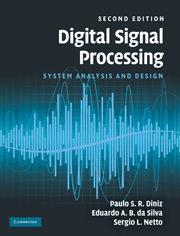Book contents
- Frontmatter
- Contents
- Preface
- Introduction
- 1 Discrete-time signals and systems
- 2 The z and Fourier transforms
- 3 Discrete transforms
- 4 Digital filters
- 5 FIR filter approximations
- 6 IIR filter approximations
- 7 Spectral estimation
- 8 Multirate systems
- 9 Filter banks
- 10 Wavelet transforms
- 11 Finite-precision digital signal processing
- 12 Efficient FIR structures
- 13 Efficient IIR structures
- References
- Index
13 - Efficient IIR structures
Published online by Cambridge University Press: 05 June 2012
- Frontmatter
- Contents
- Preface
- Introduction
- 1 Discrete-time signals and systems
- 2 The z and Fourier transforms
- 3 Discrete transforms
- 4 Digital filters
- 5 FIR filter approximations
- 6 IIR filter approximations
- 7 Spectral estimation
- 8 Multirate systems
- 9 Filter banks
- 10 Wavelet transforms
- 11 Finite-precision digital signal processing
- 12 Efficient FIR structures
- 13 Efficient IIR structures
- References
- Index
Summary
Introduction
The most widely used realizations for IIR filters are the cascade and parallel forms of second-order, and, sometimes, first-order, sections. The main advantages of these realizations come from their inherent modularity, which leads to efficient VLSI implementations, to simplified noise and sensitivity analyses, and to simple limit-cycle control. This chapter presents high-performance second-order structures, which are used as building blocks in high-order realizations. The concept of section ordering for the cascade form, which can reduce roundoff noise in the filter output, is introduced. Then we present a technique to reduce the output roundoff-noise effect known as error spectrum shaping. This is followed by consideration of some closed-form equations for the scaling coefficients of second-order sections for the design of parallel-form filters.
We also deal with other interesting realizations, such as the doubly complementary filters, made from allpass blocks, and IIR lattice structures, whose synthesis method is presented. Arelated class of realizations is the wave digital filters, which have very low sensitivity and also allow the elimination of zero-input and overflow limit cycles. The wave digital filters are derived from analog filter prototypes, employing the concepts of incident and reflected waves. The detailed design of these structures is presented in this chapter.
IIR parallel and cascade filters
The Nth-order direct forms seen in Chapter 4, Figures 4.11–4.13, have roundoff-noise transfer functions Gi(z) (see Figure 11.16) and scaling transfer functions Fi(z) (see Figure 11.20) whose L2 or L∞ norms assume significantly high values.
- Type
- Chapter
- Information
- Digital Signal ProcessingSystem Analysis and Design, pp. 787 - 862Publisher: Cambridge University PressPrint publication year: 2010

